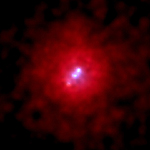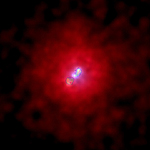3C295 in Context

Palomar Observatory image made by R. Minkowski in 1960, giving the optical identification of the central galaxy in the cluster 3C295. Angular size of box = 15 arc min.
Galaxy clusters are formed through the merger of smaller groups and clusters over billions of years. The gas in clusters is thought to have been heated to fifty million degrees or more when the cloud collapsed about five to ten billion years ago. Galaxy clusters are the most massive gravitationally bound objects in the universe.

X-ray image of 3C295
NASA/CXC/SAO
The gas in the central regions of the 3C295 cluster shows signs that it is cooling and settling onto the central galaxy. Astronomers think that the material falling onto 3C295 over the eons has caused it to grow into its present size and shape. It contains several times the mass of our Milky Way galaxy and resembles a giant glowing basketball.
The explosion that wracked 3C295 about a million years ago and produced the X-ray knots and radio lobes was probably due to the infall of gas onto the galaxy. In much the same way that a torrent of water pouring down a drain can produce a back pressure if the flow is more than the drain can handle, the enormous energy released by too much matter flowing into a supermassive black hole could trigger an explosion. Great quantities of matter and energy would be hurled back into the surrounding gas cloud, in a powerful payback for eons of being dumped on by a cosmic bully.
Return to 3C295 (16 Nov 99)



